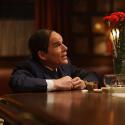Does it matter if film dies? Keanu Reeves, always cannier than his limited acting style suggests, produces and presents this even-handed documentary on analogue’s apparently fatal decline in the face of a very recent digital onslaught. His contact book brings enviable witnesses to the stand for director Chris Kenneally. If the world-famous directors and generations of legendary cinematographers don’t know the answer, maybe there isn’t one yet.
Side by Side is partly a manual in how films are made, the way in which light pours through camera apertures to create images, and the changes digital cameras have caused to that work. This new hardware has revolutionised film economics and, less obviously, on-set hierarchies. The power of the cinematographer’s camera to control images the director can only guess at till the rushes reveal all, is almost at an end. “They loved the voodoo of it,” David Fincher simmers of these celluloid priests, bemoaning the times when they “betrayed” his intentions. Martin Scorsese, whose recent work shows the strain of a director trying to keep up, misses the contemplative gap between shooting and viewing rushes allowed. A reduction in the waiting around so fundamental to film-making alters acting, too. Fincher recalls Robert Downey Jr. pissing in jars as a dirty protest as a shoot dragged on. Reeves, though, lets his A Scanner Darkly director Richard Linklater know that the sudden absence of pauses for reel-changes shattered him. Such hands-on familiarity makes Reeves a valuable, enthusiastic interviewer.
 Guerrilla-minded directors such as Steven Soderbergh and Robert Rodriguez are delighted at the independence and power digital equipment gives them. Soderbergh’s Che couldn’t have been made on its budget without lightweight digital cameras to penetrate tropical locations. Danny Boyle and Dod Mantle legitimised this technology and began its swift triumph in Slumdog Millionaire. Asked for the advantages of film, Soderbergh spits: “There are none. I hate it.”
Guerrilla-minded directors such as Steven Soderbergh and Robert Rodriguez are delighted at the independence and power digital equipment gives them. Soderbergh’s Che couldn’t have been made on its budget without lightweight digital cameras to penetrate tropical locations. Danny Boyle and Dod Mantle legitimised this technology and began its swift triumph in Slumdog Millionaire. Asked for the advantages of film, Soderbergh spits: “There are none. I hate it.”
Counter-arguments by Christopher Nolan and his cinematopher Walter Pfister insist the resolution and sensually subtle colour spectrum of 35mm is vastly superior to any digital alternative, meaning The Dark Knight trilogy (with Heath Ledger, pictured above) remained analogue. George Lucas brushes this aside, saying film is at its optimum, and the digital future will inevitably plough past it. Digital technology “doubles in everything” every two years. Anyone who strained their eyes at The Hobbit’s 48 frames-per-second 3D might well ask: why? But few are. When Paul Thomas Anderson’s The Master premiered with a London run in 35mm last year, it was the ceremonial indulgence of an art-house King Canute, not meaningful resistance.
 Film, the defining medium of 20th century modernity, is at the moment of its apparent passing valued for its naturalness. Taxi Driver cameraman Michael Chapman says they were “bringing emotion into the light”. The grains in film move; digital is fixed. In the last year I’ve felt the contrast between the richly textured reels of Robert Altman’s McCabe and Mrs. Miller (pictured above) breaking at the NFT and being swiftly respliced by trained projectionists, and the chilly, helpless pause when the digital connection crashes in a vacant projection booth.
Film, the defining medium of 20th century modernity, is at the moment of its apparent passing valued for its naturalness. Taxi Driver cameraman Michael Chapman says they were “bringing emotion into the light”. The grains in film move; digital is fixed. In the last year I’ve felt the contrast between the richly textured reels of Robert Altman’s McCabe and Mrs. Miller (pictured above) breaking at the NFT and being swiftly respliced by trained projectionists, and the chilly, helpless pause when the digital connection crashes in a vacant projection booth.
Film’s durability could yet save it. Digital technology is heedlessly advancing into a future where it may itself be displaced. Properly preserved cans of film remain the only reliable way to archive cinema. Open one, and its magic works with enduring simplicity. When the light passes through, the image lives.














Add comment